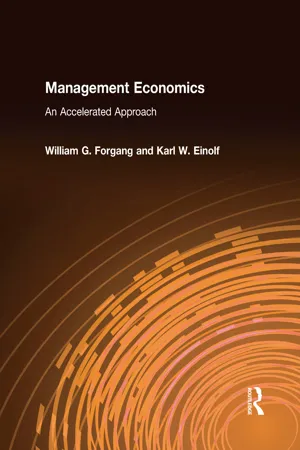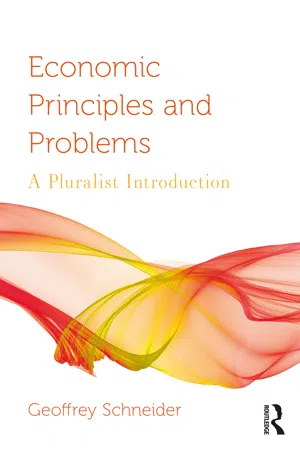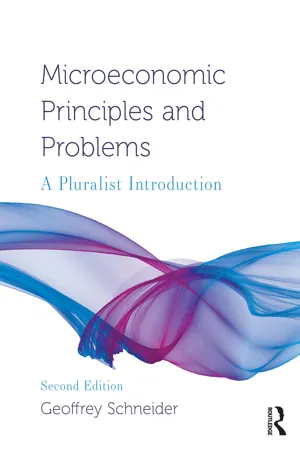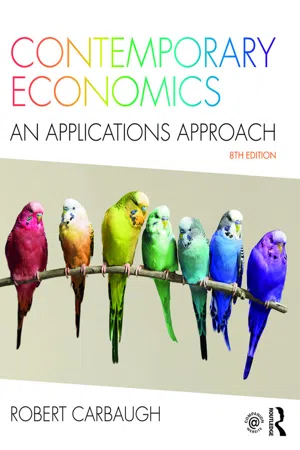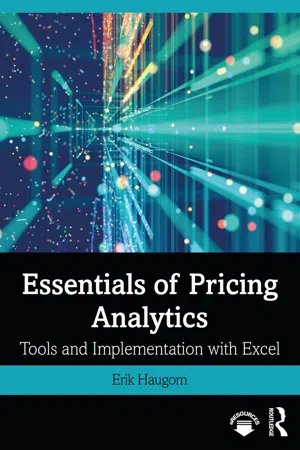Economics
Price elasticity of supply
Price elasticity of supply measures the responsiveness of the quantity supplied of a good to a change in its price. It is calculated as the percentage change in quantity supplied divided by the percentage change in price. A high price elasticity of supply indicates that producers can quickly adjust their output in response to price changes, while a low elasticity suggests that producers are less able to adjust their output in the short run.
Written by Perlego with AI-assistance
Related key terms
11 Key excerpts on "Price elasticity of supply"
- eBook - ePub
- Rob Dransfield(Author)
- 2013(Publication Date)
- Routledge(Publisher)
Price elasticity of demand – measures the percentage change in quantity demanded caused by a percentage change in price. As such, it measures the extent of movement along the demand curve.Price elasticity of supply – measures how the amount of a good firms wish to supply changes in response to a change in price. Price elasticity of supply captures the extent of movement along the supply curve.In the analysis that follows we will first review elasticity of demand before going on to examine elasticity of supply. Business managers are particularly interested in the extent to which demand is likely to respond to a price change. Measuring the response is referred to as the measurement of price elasticity. In addition, it is helpful to measure the responsiveness of demand to variables other than price – for example:- The responsiveness of demand for a good to changes in the prices of other goods – referred to by economists as cross-price elasticity.
- The responsiveness of demand for a good to changes in income – referred to by economists as income elasticity.
A restaurant owner who is considering increasing prices will first want to know what teffect this will have on the customers. Will there be no effect, a small fall in customers, or a large fall? If the number of customers remains the same or falls by a smaller percentage than the price change, the business will make more revenue. The calculation used to estimate this effect is price elasticity of demand, which measures how quantity demanded for a product responds to a change in its price. Anyone wishing to raise or lower prices should first estimate the price elasticity.Measuring price elasticity Key TermPrice elasticity - eBook - ePub
Management Economics: An Accelerated Approach
An Accelerated Approach
- William G. Forgang, Karl W. Einolf(Authors)
- 2015(Publication Date)
- Routledge(Publisher)
Figure 4.12 , assume the price rises from $5 to $8. This increase is 60 percent. In response, the quantity supplied increases from fifteen to eighteen units, a 20 percent change. The Price elasticity of supply over the range from $5 to $8 is 0.33 (= 20% ÷ 60%). The result of the calculation is a positive number, reflecting the direct relationship between price and the quantity supplied. The value is less than 1, so supply is price-inelastic over the given range of the supply curve. As with price elasticity of demand, the calculation of the Price elasticity of supply relies upon the all-else-equal assumption.Figure 4.12 Price elasticity of supplyDeterminants of the Price elasticity of supply
The Price elasticity of supply depends upon four factors: substitutability, capacity, marginal cost, and time.The more readily productive resources shift from one good to another, the greater the supply elasticity. For example, a farmer planted a field of corn. If the price of corn rises, the farmer cannot increase production until the following growing season, when acreage can be shifted from the production of soybeans to corn.A firm operating at 100 percent capacity is unable to increase the quantity supplied in response to a price increase. The supply is price-inelastic. Similarly, where a good or service is unique (such as an original painting by Picasso), the quantity supplied is insensitive to the price.The more costly it is to produce the next unit of output, the more price-inelastic the supply. For example, if to increase production a manufacturer needs a second and more costly second shift of workers, this increase in the cost of producing the next unit discourages additional production. The supply is price-inelastic.Application Box 4.15The Price elasticity of supply has important macro- and microeconomic consequences.In macroeconomics, consider the aggregate supply curve (see page 64 - eBook - ePub
Economic Principles and Problems
A Pluralist Introduction
- Geoffrey Schneider(Author)
- 2021(Publication Date)
- Routledge(Publisher)
SUVs ), giving SUVs a cross-price elasticity e SUVs-Gas = −0.3. Similarly, meat and potatoes are complements for many consumers, with a cross-price elasticity of −0.2.We also find goods that are neither substitutes nor complements for each other, in which case the cross-price elasticity is zero. The price of Coca-Cola has no impact on the demand for iPhones, so e Coke-iPhones = 0.Now that we have studied how elasticities affect the demand curve, we can move on to the Price elasticity of supply, which helps us determine when supply curves are elastic or inelastic.10.8 Price elasticity of supply
The Price elasticity of supply measures the responsiveness of quantity supplied to changes in price. In mathematical terms, the Price elasticity of supply, e s , is equal to the percentage change in the quantity supplied divided by the percentage change in price. The Price elasticity of supply is greater than or equal to 0, e s ≥0, because of the positive slope of the supply curve. The formula for the Price elasticity of supply, e s , ise s==Δ QQ 1Δ PP 1.Q 2−Q 1Q 1P 2−P 1P 1The formula for the Price elasticity of supply is the same as the formula for the price elasticity of demand, but we use two points along the supply curve to compute it. For example, in Figure 10.18 (a) we see an elastic supply curve for hamburgers. The supply of hamburgers is elastic because there is a large amount of frozen hamburgers available in storage, so suppliers can get more hamburgers very easily in the short run if demand increases. In Figure 10.18 (a), the demand for hamburgers increases, shifting to the right from D1 to D2 - eBook - ePub
Microeconomic Principles and Problems
A Pluralist Introduction
- Geoffrey Schneider(Author)
- 2024(Publication Date)
- Routledge(Publisher)
SUVs–Gas = −0.3. Similarly, meat and potatoes are complements for many consumers, with a cross-price elasticity of −0.2.We also find goods that are neither substitutes nor complements for each other, in which case the cross-price elasticity is 0. The price of Coca-Cola has no impact on the demand for iPhones, so eCoke-iPhones = 0.Now that we have studied how elasticities affect the demand curve, we can move onto the Price elasticity of supply, which helps us determine when supply curves are elastic or inelastic.10.8 Price elasticity of supply
The Price elasticity of supply measures the responsiveness of quantity supplied to changes in price. In mathematical terms, the Price elasticity of supply, eS , is equal to the percentage change in the quantity supplied divided by the percentage change in price. The Price elasticity of supply is greater than or equal to zero, eS ≥ 0, because of the positive slope of the supply curve. The formula for the Price elasticity of supply, eS , is:e S==▵ QQ 1▵ PP 1.(Q 2−Q 1)Q 1(P 2−P 1)P 1Price elastic and price inelastic supply curves.FIGURE 10.18The formula for the Price elasticity of supply is the same as the formula for the price elasticity of demand, but we use two points along the supply curve to compute it. For example, in Figure 10.18(a) we see an elastic supply curve for hamburgers. The supply of hamburgers is elastic because there is a large amount of frozen hamburgers available in storage, so suppliers can get more hamburgers very easily in the short run if demand increases. In Figure 10.18(a) , the demand for hamburgers increases, shifting to the right from D1 to D2 - eBook - ePub
An Introduction to Economics
Concepts for Students of Agriculture and the Rural Sector
- Berkeley Hill(Author)
- 2021(Publication Date)
- CAB International(Publisher)
Fig. 3.13 shows a rather odd supply curve occasionally encountered, especially when producers have invested heavily in specialist buildings and equipment (i.e. they have high ‘fixed costs’), such as is required in modern large-scale egg production. If prices are lowered to a certain point P, the quantity supplied contracts in the typical way, but if prices are lowered further, supply increases. This can be explained by producers trying to maintain their incomes by producing more as prices fall. For example, a farmer faced with a fall in the price of eggs might cram an increased number of birds into his hen house and aim for a higher output. Although profit per egg would fall with a fall in price, by achieving a higher output his overall profit may be maintained or even increased. This type of response, however, will only happen if there is a positive margin above variable costs (such as poultry feed) and should be treated as short term and exceptional.Fig. 3.13 Supply curve that is partially ‘reverse’.The responsiveness of producers in terms of output to changes in the price of their product is measured by the Price elasticity of supply (ESp ). It is defined by the formula at the bottom of the page.The word ‘price’ is often dropped from the title. Usually the elasticity of supply is a positive figure. (It is only negative in the exceptional circumstances of the ‘reverse’ supply curve, when the quantity supplied increases when prices fall.)For some commodities the quantity supplied is extremely responsive to price changes. Such supply is called elastic and the ESp would be high. Where changes in supply occur without any change in price being necessary, supply is called infinitely elastic . An example might be an ice cream seller at the seaside: within a given range of quantities the vendor is willing to sell as much or as little as buyers want without changing the prices. At the other extreme, the quantity supplied is very unresponsive, possibly totally unresponsive, to price changes. An example is Cup Final tickets; once the arena has been sold out, however high the ‘black market’ price rises, no more seating spaces can be supplied. In such a situation, supply is completely inelastic.Figure 3.14 shows what happens when a change in demand, caused perhaps by an increase in consumers’ incomes, meets supply situations of infinitely elastic supply (Fig. 3.14a ), completely inelastic supply (Fig. 3.14c ), and an intermediate case (Fig. 3.14b - eBook - ePub
- Neil Harris(Author)
- 2007(Publication Date)
- Routledge(Publisher)
S > 1), where a change in price will lead to a greater than proportionate change in quantity supplied. These are the two cases most important to business economics. For completeness, however, we should also briefly consider the other cases.Figure 6.6 shows a supply curve (S0 ) which is perfectly inelastic, so ES = 0. Here supply is totally fixed at Q0 regardless of price, so as demand rises over time (draw in a series of demand curves, one above the other), supply stays constant and only price increases. An example of this would be the supply of original manuscripts of Jane Austen novels since the world will never see more of these written. Figure 6.6 also shows a different supply curve S1 ; this is a perfectly elastic supply curve such that businesses will supply whatever amount is demanded at the price of P0 but none at any price below P0 . Here ES = 4. One example of this, at times, is the supply of crude oil put onto the market by OPEC (the Organisation of Petroleum Exporting Countries). When prices fell to $10 per barrel, oil exporting countries were willing to supply as much as industrial countries would demand to try and keep up their oil revenues as much as possible.Figure 6.6 Perfectly elastic and inelastic supply curves.Factors Influencing the Elasticity of SupplyA number of factors influence the elasticity of supply for a product. The main ones are: (i) the time span; (ii) the extent to which costs increase as output increases and (iii) the elasticity of supply of the inputs which make up the product.The Time SpanThe longer the time span the more elastic will any supply curve become as new supplies or more substitutes are developed. In the very short term supply is totally fixed so the supply curve is perfectly inelastic. In the short term only variable inputs can be increased so the supply curve will be a little more elastic. In the long term, however, fixed factors can be varied and new businesses will enter the industry also increasing supply. Therefore, the supply curve will become more elastic as time progresses. - Available until 20 Jul |Learn more
Contemporary Economics
An Applications Approach
- Robert Carbaugh(Author)
- 2016(Publication Date)
- Routledge(Publisher)
Government officials in California have traditionally attempted to ensure cheap electricity for state residents by mandating price ceilings on the retail price. Yet in 2001, a robust economy and unseasonably cold weather caused the demand for electricity to rise faster than supply could respond. California’s utility companies thus had to purchase power from out-of-state utilities at very high prices and then sell it to consumers at the low, state-controlled prices. Without the price ceiling, the shortage of electricity would have caused power prices to rise until demand and supply came into balance. Businesses and households would have voluntarily responded to the higher prices by reorganizing production, turning down thermostats, and shutting off lights. With the price ceiling, however, shortages prevailed, imposing more hardship on Californians.The previous chapter introduced demand and supply analysis of market transactions. We learned that competitive markets can guide the allocation of resources to produce the goods and services that people demand. This chapter will broaden our understanding of demand and supply analysis. We will consider how sensitive buyers or sellers really are to a change in price. We will also examine whether a seller’s revenue rises or falls following a change in price. Finally, as an application of demand and supply principles, we will analyze the potential effects of government price ceilings and floors on individual markets.Price Elasticity Of Demand
Suppose that you are the ticket manager for the Los Angeles Lakers, a professional basketball team. You are contemplating an increase in the price of your tickets, and you wonder how your fans will react. According to the law of demand, an increase in price will result in a decrease in quantity demanded. But how much will the quantity demanded fall in response to the price hike? The answer to your question depends on the price elasticity of demand.The price elasticity of demand measures how responsive, or sensitive, buyers are to a change in price. The price elasticity of demand looks at the percentage change in quantity demanded relative to the percentage change in price. The elasticity formula isE d=Percentage change in quantity demanded Percentage change in pricewhere Ed is the elasticity coefficient.11 The midpoint formula is used to calculate the elasticity between two points on a demand curve (or supply curve). This formula uses the averages of the two quantities and the two prices under consideration as reference points. According to the midpoint formula, the percentage change in quantity equals the change in the quantity divided by the average of the two quantities; the percentage change in price equals the change in price divided by the average of the two prices. Therefore, the price elasticity of demand equals:E d=Change in quantity÷Sum of quantities / 2Change in priceSum of prices / 2 - eBook - ePub
- Dr Paul Balchin, Paul Balchin, Maureen Rhoden(Authors)
- 2002(Publication Date)
- Routledge(Publisher)
Household Expenditure Survey (Office of Population Censuses and Surveys, 1992) show that, whereas households in the top two deciles of income spend only around 17 per cent of their income on housing (net expenditure), the proportion spent by households in the second and third deciles is nearly 25 per cent.Price elasticity of supply
The elasticity of supply (Es) measures the degree of responsiveness of quantity supplied to changes in the market price of the commodity. As such it can be defined asThe value of Es ranges from zero to infinity (shown by S0and S1respectively in Figure 2.13 ). Zero elasticity is quite rare (it implies there is no change in quantity supplied to q0whatever the price), as is infinite elasticity (it implies that an infinite quantity can be supplied at P0). In reality most supply schedules fall somewhere in between. Figure 2.13b shows that any straight-line supply curve passing through the origin (0) will have an elasticity equal to unity. To confirm this we can see that doubling the price from P0to P1results in a doubling of quantity supplied in both supply curves, S2and S3.For some commodities, such as housing (which takes months or even years to plan and construct), there may be a considerable contrast between inelastic supply in the short term and elastic supply in the longer term. This may indeed provide one of the main explanations for the inherent instability of the owner-occupied housing market as illustrated in Figure 2.14 . A shift in demand for owner-occupation (D0to D1) can occur quite rapidly for a number of reasons: a fall in interest rates, population growth, expectations of future price rises, or a rise in government subsidy being the most obvious. In the short term the supply cannot be expanded quickly and the market equilibrium will move towards e 1 and a market price of P1. Higher house prices will encourage house-builders to expand output and eventually a new long-run equilibrium will be achieved at e2. Clearly it would be advantageous all round for the market to move directly from e0to e2(to avoid prices rising and falling again from P1to P2). This can, however, only be achieved if either the shift outwards of the demand curve from D0to D1 - eBook - ePub
The Industrial System (Routledge Revivals)
An Inquiry into Earned and Unearned Income
- J. Hobson(Author)
- 2013(Publication Date)
- Routledge(Publisher)
in the amount of money consumers are willing and able to pay for a supply of goods at the current price, will, through causing a larger or a smaller supply to be produced, alter the methods of production, the positive and relative amounts of the various factors of production, and the prices that are paid per unit for their use, so raising and lowering the margins of employment, extensive and intensive, of each factor. Still more important are the influences which the rise or fall of demand prices for staple materials of manufacture exert upon the structure of whole groups of trades, and so upon the supply prices of the goods they make. The rise of demand prices for such articles as copper, rubber, oil, paper, leather, due to new or increased demands for electric apparatus, motors, cheap literature, &c., have altered the economic and even the political administration of whole provinces. § 6.—The elasticity of supply, i.e. the response which expenses of production make to a rise or a fall of demand at previous prices, is much less calculable than the elasticity of demand. For, whereas the latter commonly depends upon the gradual action of large bodies of consumers altering their habits of consumption, the former is usually achieved by quick changes in methods of production spreading rapidly over whole trades of producers. Production is normally less conservative than consumption, and is more alert to seize and adopt new economies. For though habits of industry make for themselves deep grooves, and labour, capital, and ability, being specialised in certain methods, resist innovations which, however beneficial in the long run, involve present trouble and loss, competition forces reforms - eBook - ePub
Microeconomics
A Global Text
- Judy Whitehead(Author)
- 2014(Publication Date)
- Routledge(Publisher)
P = 1 in absolute terms), the percentage change in the quantity demanded is exactly equal to the percentage change in price but in the opposite direction. Consequently, if price is reduced by a certain proportion (say 10 per cent), the quantity demanded is increased by the same proportion (10 per cent) and similarly for a price decrease. Consequently, neither a price increase nor a price decrease would affect the total expenditure on the product and so the seller’s revenue from the sale of the product remains unchanged with a change in price.The value of the price elasticity of demand depends on:- The availability of substitutes . Demand for a commodity is more price elastic where there are close substitutes.
- The extent to which the commodities may be characterized as luxuries or necessities . Luxury goods are more price elastic whereas necessities are more inelastic.
- Time period . Demand is more price elastic in the long-run than in the short-run.
- Alternative uses . The more alternative uses a commodity has, the greater the price elasticity of demand.
- The proportion of total income spent on the product . The greater the proportion the higher the elasticity.
Arc elasticity of demand
The above measures of price elasticity of demand refer to what may be called the point elasticity of demand. This is appropriate for small changes in price. For larger changes in price, the formula for arc price elasticity of demand is used. This may be expressed (with the subscript x omitted) as:3.2.2 The PCC and the price elasticity of demandPrice elasticity of demand may be determined from the shape of the price consumption curve (PCC ). As explained in Chapter 2 , the price consumption curve is the line joining successive equilibrium points as the price of good x falls. The price elasticity of demand can be derived from the price consumption curve using money and one good (x - eBook - ePub
Essentials of Pricing Analytics
Tools and Implementation with Excel
- Erik Haugom(Author)
- 2020(Publication Date)
- Routledge(Publisher)
elastic (right panel) demand curves, as usually presented in microeconomic texts. In this case, price is a function of demanded quantity. Both ways of illustrating the price elasticity of demand induce the same conclusion, though. For a price change of a given magnitude, the change in demand will be (relatively) high if demand is elastic and (relatively) low if demand is inelastic.Figure 5.2 Illustration of inelastic (left panel) and elastic (right panel) demand. In the upper panel demand is used on the Y-axis (as commonly done in price–response functions). The lower panel illustrates inelastic and elastic demand with price on the Y-axis (as commonly done in the economics literature).We now understand that the price elasticity of demand is determined by the steepness of the price–response function. This statement is a little too general, though. The reason is that for most functional forms of price–response functions, the estimate of the price elasticity will depend on what part of the curve we choose to use to calculate an elasticity estimate. To see this, consider the following expression that can be used to estimate the price elasticity of demand:ε =(5.2)(/ dd)(− dp 2)(p 1)(p 1)(/)p 2−p 1p 1This measure is known as the point elasticity of demand , although it requires two combinations of prices and quantities. This estimate will depend on both the old price(and the new pricep 1)(, and where we are on the price–response function (the general level of demand at the two prices). An example is given below.p 2)Example 5.1: Calculation of price elasticity of demand for a specific product.A company increased the price of one of its products from $59 to $64. As a result, the sales went down from 12,000 units to 11,300 units. What is the point elasticity in this case?
Learn about this page
Index pages curate the most relevant extracts from our library of academic textbooks. They’ve been created using an in-house natural language model (NLM), each adding context and meaning to key research topics.

